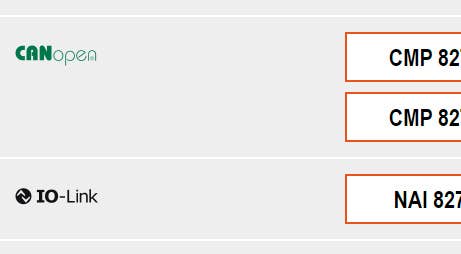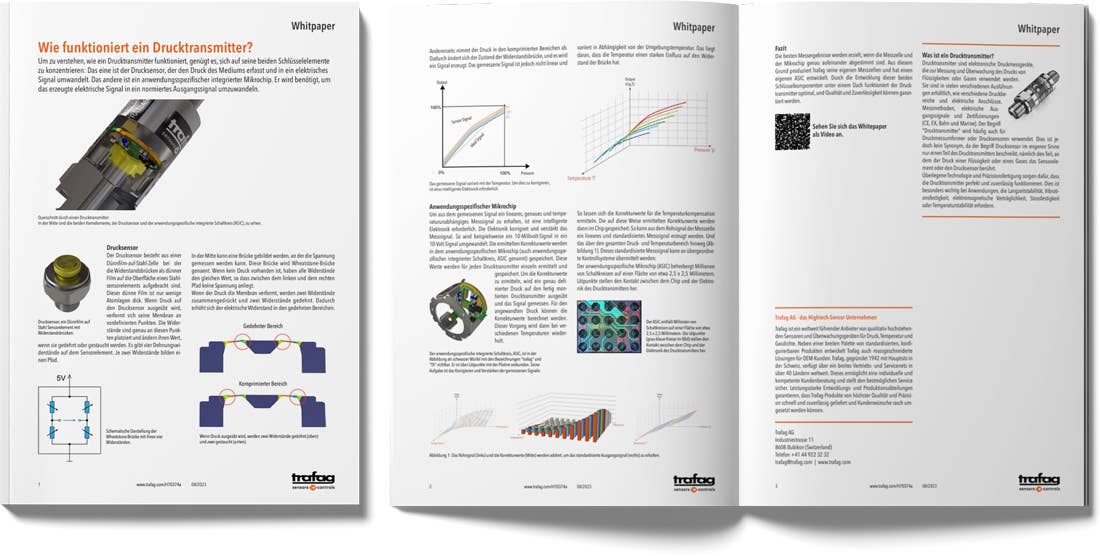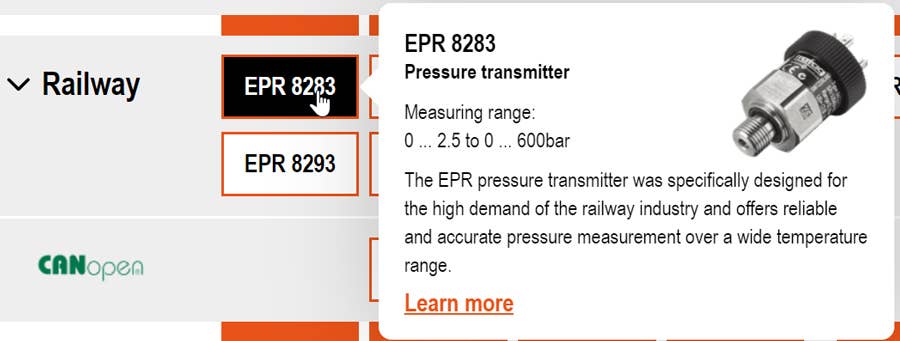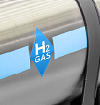Pressure transmitter product portfolio from Trafag
To see the entire content, please click on the respective line (in gray) to expand it.
Trafag offers a broad and deep range of pressure transmitters optimized for the specific requirements in a wide variety of applications. The extensive portfolio, which has grown continuously over a period of more than two decades, is clearly structured to allow rapid identification of the most suitable product. With the help of the table, the suitable product can be easily identified:
The gray rows (horizontal) show the target applications and the corresponding standard requirements. The orange columns (vertical) show the internal structure and the product families.


Target applications
The main applications for pressure transmitters can be found in the product groups «Industry», «Railways», «Shipbuilding and large engines», «Hydrogen» and «Test and test bench technology» and thus in the first column:
- The «Industry» product group includes products that do not meet any special standards and are frequently used in hydraulic or pneumatic applications as well as in machines and systems for measuring the pressure of a wide variety of gases and liquids.
- In «railroad technology» for trains, pressure transmitters are used that must comply with certain railroad standards such as EN 50155.
- In «shipbuilding», approvals from classification societies are required. In addition, approved pressure transmitters are used in «engines». Therefore, these two groups are shown in the table in the same area.
- Pressure transmitters for «hydrogen applications» require a sensor measuring cell and other wetted parts that are compatible with hydrogen.
- Pressure transmitters for «test and test bench technology» are characterized by a particularly high measuring accuracy.
As a subgroup of the target applications, models are highlighted in each case that have either approvals for explosion-proof areas or digital output signals such as CANopen or IO-Link.
Internal structure of pressure transmitters
The internal structure of pressure transmitters is classified according to the sensor technology used. So thin-film-on-steel, thick-film-on-ceramic as well as piezoresistive sensors.
Products with the same sensor technology are available in different versions, each adapted to the requirements of the target application. The product families differ in design and size.
- The pressure transmitters with thin-film-on-steel sensors are available in width across flats (SW or HEX) 19mm and 27mm, with display as well as in special versions, such as flush-mounted sensor diaphragm.
- Thick-film-on-ceramic and piezoresistive sensor technology are used in submersible products for level measurement of liquids.
- Variants with a digital display are available for products with both thin-film-on-steel and thick-film-on-ceramic sensor cells.
Trafag pressure transmitters are always marked with a four-digit product number and a three to four-digit product designation. The designation stands for a specific product type within a product family. The numerical code distinguishes between different generations of the same product type.
For example: The thin-film-on-steel pressure transmitters of width across flats 27 (without Ex approval) belong to the EPx product family, where the small x stands for the designation of the target application of the respective model (I=Industry, R=Railway, N=Naval). So EPR is a SW27 wrench size pressure transmitter with a thin-film-on-steel sensing element for railroad applications. It is available with product code 8283 and 8293. The difference between the two codes is the product generation: the EPx with code 828x are the newer generation, the EPx with code 829x are based on the older chip technology. Click on the link in the context menu, you will learn more about the product and also get to the data sheet with all relevant technical specifications.
The current structure was not created on the drawing board, but has grown over many decades. Therefore, there are various exceptions to the rules described above for the labeling of product families. Furthermore, there are products that can be used in several application areas and are therefore listed several times in the overview table.
If you are not sure which Trafag product is best suited for your application, please contact us. Our specialists will be happy to provide you with competent and comprehensive advice.
Our pressure transmitters in detail
-
 NAI 8273Out of stock
NAI 8273Out of stock -
 FPI 8237Out of stock
FPI 8237Out of stock -
 NHT 8250Out of stock
NHT 8250Out of stock -
 FPT 8236Out of stock
FPT 8236Out of stock -
 NAE 8256Out of stock
NAE 8256Out of stock -
 CMP 8271Out of stock
CMP 8271Out of stock -
 EXNT 8292Out of stock
EXNT 8292Out of stock -
 EXNAL 8858Out of stock
EXNAL 8858Out of stock -
 EXNA 8854Out of stock
EXNA 8854Out of stock -
 EXNA 8852/8853Out of stock
EXNA 8852/8853Out of stock -
 ESH 8845Out of stock
ESH 8845Out of stock -
 EXNAL 8859Out of stock
EXNAL 8859Out of stock -
 NAL 8838Out of stock
NAL 8838Out of stock -
 ECR 8478Out of stock
ECR 8478Out of stock -
 ECTN 8477Out of stock
ECTN 8477Out of stock -
 ECT 8473Out of stock
ECT 8473Out of stock -
 ECT 8472Out of stock
ECT 8472Out of stock -
 ECL 8439Out of stock
ECL 8439Out of stock -
 DPS 8381Out of stock
DPS 8381Out of stock -
 DPC 8380Out of stock
DPC 8380Out of stock -
 EPN-S 8320Out of stock
EPN-S 8320Out of stock -
 EPN/EPNCR 8298Out of stock
EPN/EPNCR 8298Out of stock -
 EPR 8293Out of stock
EPR 8293Out of stock -
 EPN 8288Out of stock
EPN 8288Out of stock -
 EPI 8287Out of stock
EPI 8287Out of stock -
 EPR 8283Out of stock
EPR 8283Out of stock -
 NPN 8264Out of stock
NPN 8264Out of stock -
 NAR 8258Out of stock
NAR 8258Out of stock -
 NAR 8258Out of stock
NAR 8258Out of stock -
 NSL 8257Out of stock
NSL 8257Out of stock -
 NAE 8256Out of stock
NAE 8256Out of stock -
 NAH 8254 20 kHzOut of stock
NAH 8254 20 kHzOut of stock -
 NAH 8254Out of stock
NAH 8254Out of stock -
 NAH 8254Out of stock
NAH 8254Out of stock -
 NAH 8253Out of stock
NAH 8253Out of stock -
 NAT 8252Out of stock
NAT 8252Out of stock -
 NAT 8252Out of stock
NAT 8252Out of stock -
 H 8212/8213Out of stock
H 8212/8213Out of stock -
 ND 8204Out of stock
ND 8204Out of stock -
 N 8202Out of stock
N 8202Out of stock -
 NAP 8842/8843Out of stock
NAP 8842/8843Out of stock







